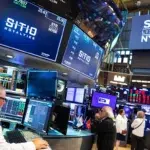A spat between Changpeng Zhao and Sam Bankman-Fried could spark a crypto cold war between the two largest exchanges in the space.
Binance plans to eliminate FTT exposure
A conflict is brewing between two of the biggest whales in crypto. Binance founder and CEO Changpeng “CZ” Zhao revealed on Sunday that his company would be liquidating its exposure to FTX’s FTT token, received as part of Binance’s exit from FTX last year.
As part of Binance’s exit from FTX equity last year, Binance received roughly $2.1 billion USD equivalent in cash (BUSD and FTT). Due to recent revelations that have come to light, we have decided to liquidate any remaining FTT on our books. 1/4
– CZ 🔶 Binance (@cz_binance) November 6, 2022
On Twitter, Zhao mocked that the liquidation was due to “recent revelations“, and assured his followers that the removal of exposure to Binance’s FTT tokens was not done in order to attack his competitor. However, FTX CEO Sam Bankman-Fried didn’t see it that way. “A competitor is trying to come after us with false rumors. FTX is fine. Assets are fine.“, he stated explaining that its exchange did not invest its customers’ assets, that it had processed all withdrawals, and that it would continue to do so.
1) A competitor is trying to go after us with false rumors.
FTX is fine. Assets are fine.
Details:
– SBF (@SBF_FTX) November 7, 2022
Although the value of the FTT tokens held by Binance is unknown, the exchange received a total of $2.1 billion in Binance USD (BUSD) and FTT when it exited FTX last year. Yesterday, Zhao confirmed that that a transaction of 22.9 million FTT tokens, worth $584 million, represented only a portion of the exchange’s total FTT holdings. This one transaction is equivalent to 17.2 percent of the total FTTs outstanding.
Yes, this is part of it. https://t.co/TnMSqRTutr
– CZ 🔶 Binance (@cz_binance) November 6, 2022
There are several possible reasons why Zhao decided to reduce Binance’s exposure to FTX. The most important is the recent revelation that FTX’s trading affiliate, Alameda Research, may be facing financial difficulties, according to an update disclosed by Binance. CoinDesk. The paper showed that as of June 30, Alameda held more than $14.6 billion in assets against $7.4 billion in liabilities. However, since most of the company’s assets consisted of highly liquid tokens such as FTT, SRM, MAPS, and OXY, there were doubts about Alameda’s ability to repay its debts.
In addition, observers such as Dirty Bubble Media have alleged that the FTT token, which makes up a significant portion of Alameda’s and FTX’s balance sheets, has a highly inflated value. They explain that using a flywheel scheme, Alameda and FTX created the illusion of demand, which inflated the price of FTT and allowed both parties to take out large loans against their FTT holdings. However, now that Alameda Research appears to be running out of cash, as evidenced by the recently disclosed balance sheet, the FTT flywheel is under pressure.
In response to these accusations, Alameda Research CEO Caroline Ellison denied that her trading company was in such dire straits. On Twitter, she said claimed that that the balance sheet leak involved only a subset of Alameda’s entities, adding that the company held an additional $10 billion in assets.
A few notes on the balance sheet info that has been circulating recently:
– that specific balance sheet is for a subset of our corporate entities, we have > $10b of assets that aren’t reflected there– Caroline (@carolinecapital) November 6, 2022
In addition, Ellison responded to to Zhao’s intention to sell Binance’s FTT exposure by offering to buy all of his company’s tokens at $22 a piece. This begs the question: why doesn’t Alameda want FTT to fall below $22? Many have speculated that it’s because much of Alameda’s liabilities are secured by the FTT. The company could start facing margin calls on its loans if the FTT falls well below $22. On the other hand, Ellison may have simply chosen $22 for his buyout offer because that’s what the token was trading at the time of his tweet.
@cz_binance if you’re looking to minimize the market impact on your FTT sales, Alameda will happily buy it all from you today at $22!
– Caroline (@carolinecapital) November 6, 2022
In any event, Zhao seems to believe that the risk of holding FTTs now outweighs the potential gains. Whether Zhao intended to do so or not, his actions were seen by Bankman-Fried and the crypto community at large as a kick to FTX by Binance. Whether or not these two crypto whales can put their differences aside and find a solution to their current feud will likely have a significant impact on the crypto space in the future.
A Cryptographic Cold War
If Bankman-Fried and Zhao can’t resolve their differences soon, it could result in a protracted conflict between two of the largest crypto-currency exchanges.
Zhao made it clear in his initial announcement that he wants to eliminate Binance’s exposure to the FTT in a way that “minimizes the impact on the market“. If he truly has no ulterior motive, it would make sense to accept Ellison’s offer to buy back his FTT position for $22 per token. Whether or not Zhao decides to sell the FTTs over-the-counter rather than directly on the market will give a good indication of his true intentions.
However, since the ball is well and truly in Zhao’s court, he has no obligation to accept the most favorable outcome for Alameda and FTX. From the start, Binance is undoubtedly in a stronger position – the exchange has the most liquid crypto markets in the world as well as the largest number of users. Despite past controversies, Zhao’s public perception is much better than Bankman-Fried’s today. Recent discussions around crypto-currency regulation, including a poor performance at a press conference, have been very positive. Bankless debate with ShapeShift CEO Erik Voorhees weighed on the FTX CEO’s image.
If Zhao decided to sell Binance’s FTT into the market, it would likely cause some short-term volatility and force FTX or Alameda to buy back the amount to support the token price. However, with current information, it seems unlikely that this could inflict serious damage. A greater concern for FTX is the market perception of such an event. If enough FTT holders and FTX customers lose confidence in the exchange and its token, it could cause a run on the banks, resulting in a much more serious situation.
However, what FTX and its connected entities have that Binance does not are government and regulatory connections. Bankman-Fried has much better relationships with regulators and U.S. government officials than Binance, having already testified before Congress and led efforts to draft crypto-currency regulations in Washington, D.C. FTX’s CEO has also portrayed himself as an eccentric altruist who plans to give the vast majority of his wealth to charitable causes. This image has played well with wealthy elites, earning him a spot on several magazine covers and even an audience with the well-connected Bill Clinton and Tony Blair at FTX’s crypto conference in the Bahamas earlier this year.
Conversely, Binance has struggled with regulators in the United States and abroad until recently. Throughout 2021, the company had to pull products from its exchange in several jurisdictions when it was in violation of local regulations. In Malaysia, the government even ordered a total ban on Binance, requiring the exchange to disable its website in the country. In addition, the U.S. Department of Justice requested documents from Zhao and other Binance executives related to the exchange’s anti-money laundering controls and communications addressing compliance issues. Earlier this year, a Reuters report alleged that Binance allowed more than $2.35 billion in criminal funds to flow through its exchange between 2017 and 2021.
While Zhao may have the upper hand for now, the Bankman-Fried connections could turn the tide if the current feud turns into a full-blown dispute. While both parties have expressed a desire to work together, it is not yet clear whether they will be able to put their differences aside for the sake of the broader crypto ecosystem.

 Siemens issues 1st €60M bond on public blockchain
Siemens issues 1st €60M bond on public blockchain Wall Street on a tear: retail sales data drives the rise
Wall Street on a tear: retail sales data drives the rise Web3 instant messenger SendingMe raises $12.5M
Web3 instant messenger SendingMe raises $12.5M FLOKI doubles in value after Elon Musk tweet
FLOKI doubles in value after Elon Musk tweet Floki’s listing on Binance soon confirmed, here’s why, now might be the time to invest!
Floki’s listing on Binance soon confirmed, here’s why, now might be the time to invest!